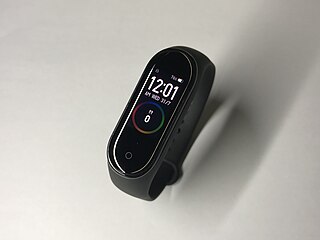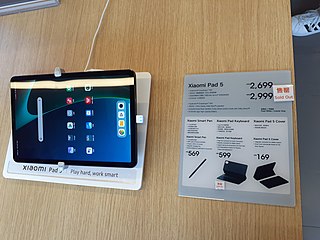This is a list of tablet computers, grouped by intended audience and form factor.

The ThinkPad X series is a line of laptop computers and convertible tablets produced by Lenovo with less power than its other counterparts. It was initially produced by IBM until 2005.
Dragontrail, manufactured by AGC Inc., is an alkali-aluminosilicate sheet glass engineered for a combination of thinness, lightness and damage-resistance, similar to Corning's proprietary Gorilla Glass. The material's primary properties are its strength, allowing thin glass without fragility; its high scratch resistance; and its hardness – with a Vickers hardness test rating of 595 to 673.
Atom is a system on a chip (SoC) platform designed for smartphones and tablet computers, launched by Intel in 2012. It is a continuation of the partnership announced by Intel and Google on September 13, 2011 to provide support for the Android operating system on Intel x86 processors. This range competes with existing SoCs developed for the smartphone and tablet market from companies such as Texas Instruments, Nvidia, Qualcomm and Samsung. Unlike these companies, which use ARM-based CPUs designed from the beginning to consume very low power, Intel has adapted the x86-based Intel Atom line of CPU developed for low power usage in netbooks, to even lower power usage.
The following is a comparison of high-definition smartphone displays, containing information about their specific screen technology, resolution, size and pixel density. It is divided into three categories, containing smartphones with 720p, 1080p and 1440p displays.

The Xiaomi Redmi Note 3 is a smartphone developed by Xiaomi Inc. as part of Xiaomi's low-end Redmi smartphone line. It has three variants:

The Xiaomi Mi Pad is a tablet computer produced by Xiaomi. It is Xiaomi's first tablet and is manufactured by Foxconn. The device is available in two storage sizes, 16 GB and 64 GB.
Xiaomi Mi MIX is an Android Smartphone manufactured by Xiaomi. It is designed by Philippe Starck, and awarded multiple top design awards for product design. It has been taken by multiple museums around the world as design collection, including Centre Pompidou in Paris and Design Museum. It is the world's 1st 3 border bezel-less phone category. It was succeeded by the Xiaomi Mi MIX 2 in September 2017, followed by the Xiaomi Mi MIX 3 on 25 October 2018 and the latest Xiaomi MIX 4 on 10 August 2021.
The Xiaomi Mi A2 is a mid-range smartphone co-developed by Xiaomi and Google as part of Android One program.

The Xiaomi Mi MIX 3 is an Android smartphone launched in Beijing on 25 October 2018. It is the successor for the Mi MIX 2 and Mi MIX 2S. This time Xiaomi uses a true bezel-less display with a magnetic sliding front camera setup.
The Redmi Note 7series refer to a series of smartphones released by Redmi, a sub-brand of Xiaomi. All have 48MP + 5MP camera sensors. Most have a Qualcomm Snapdragon 660 SoC, except the Redmi Note 7 Pro, which has a better Qualcomm Snapdragon 675 SoC. The phones support mobile network frequencies in different regions. The Note 7 is available in many local versions and a global version, compatible with mobile phone providers in most places; the Pro model is supplied in slightly different Chinese and Indian versions. The Redmi Note 7S doesn't have much difference when compared to Redmi Note 7 except in case of the rear camera, hence the production of the Redmi Note 7S was discontinued and came under the Redmi Note 7 in India but it's still available separately in China and other countries.

The Xiaomi Mi Smart Band 4 is a wearable activity tracker produced by Xiaomi Inc released in China on 16 June 2019, in Europe on 26 June 2019 and in India on 19 September 2019. It is 39.9% larger than its predecessor, has a super capacitive AMOLED display and features 24/7 heart rate monitoring.

The Xiaomi Mi 11 is an Android-based high-end smartphone designed and marketed by Xiaomi Inc. succeeding their Xiaomi Mi 10 series. The phone was launched globally on 8 February 2021.

Xiaomi Pad 5 is a line of Android-based tablet computers manufactured by Xiaomi. It was announced on August 10, 2021 with Xiaomi MIX 4.
Redmi Pad is an Android tablet computer designed, marketed and manufactured by Xiaomi. This tablet computer was announced on October 4, 2022, it was released on October 5, 2022.

The Xiaomi Mi Pad 2 is a tablet released in 2015 November shipped with either Android 5 with MIUI or with Windows 10. It is in theory possible to convert the Android model of Mi Pad 2 to Windows.
The Xiaomi Mi Pad 4 and Xiaomi Mi Pad 4 Plus is two budget tablets made by Xiaomi. It's successor, the upper mid range Xiaomi Pad 5, are not released till 2021. The Xiaomi Mi Pad 4 Plus is the larger tablet at 10.1 inches screen, while the Mi Pad 4 is 8.0 inches. Both tablets have the Qualcomm Snapdragon 660 chipset.
The Xiaomi Mi Pad 6 is a line of mid-range to high end tablets manufactured by Xiaomi.







